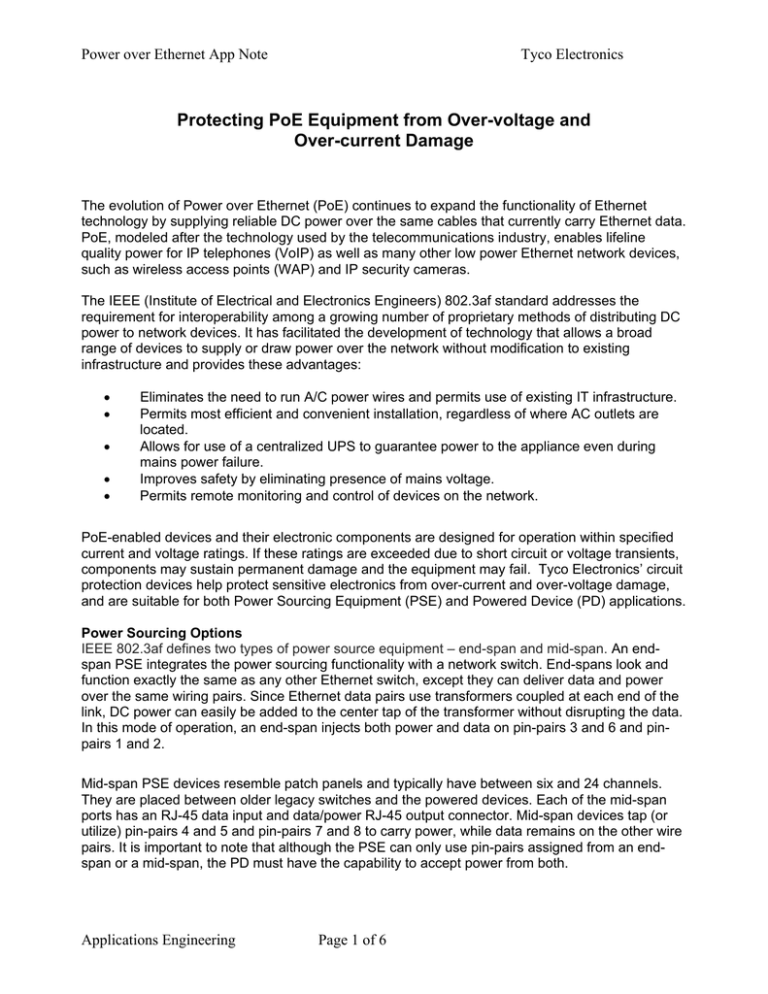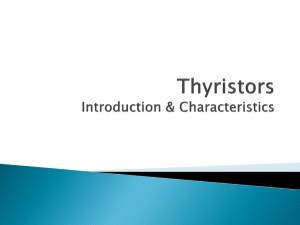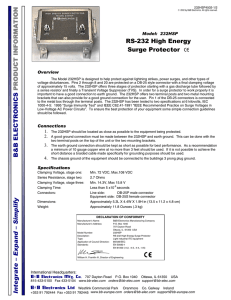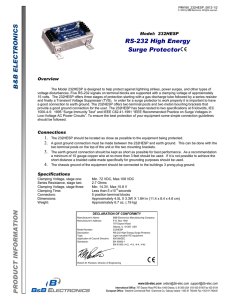Protecting PoE Equipment from Over-voltage and Over-current
advertisement

Power over Ethernet App Note Tyco Electronics Protecting PoE Equipment from Over-voltage and Over-current Damage The evolution of Power over Ethernet (PoE) continues to expand the functionality of Ethernet technology by supplying reliable DC power over the same cables that currently carry Ethernet data. PoE, modeled after the technology used by the telecommunications industry, enables lifeline quality power for IP telephones (VoIP) as well as many other low power Ethernet network devices, such as wireless access points (WAP) and IP security cameras. The IEEE (Institute of Electrical and Electronics Engineers) 802.3af standard addresses the requirement for interoperability among a growing number of proprietary methods of distributing DC power to network devices. It has facilitated the development of technology that allows a broad range of devices to supply or draw power over the network without modification to existing infrastructure and provides these advantages: • • • • • Eliminates the need to run A/C power wires and permits use of existing IT infrastructure. Permits most efficient and convenient installation, regardless of where AC outlets are located. Allows for use of a centralized UPS to guarantee power to the appliance even during mains power failure. Improves safety by eliminating presence of mains voltage. Permits remote monitoring and control of devices on the network. PoE-enabled devices and their electronic components are designed for operation within specified current and voltage ratings. If these ratings are exceeded due to short circuit or voltage transients, components may sustain permanent damage and the equipment may fail. Tyco Electronics’ circuit protection devices help protect sensitive electronics from over-current and over-voltage damage, and are suitable for both Power Sourcing Equipment (PSE) and Powered Device (PD) applications. Power Sourcing Options IEEE 802.3af defines two types of power source equipment – end-span and mid-span. An endspan PSE integrates the power sourcing functionality with a network switch. End-spans look and function exactly the same as any other Ethernet switch, except they can deliver data and power over the same wiring pairs. Since Ethernet data pairs use transformers coupled at each end of the link, DC power can easily be added to the center tap of the transformer without disrupting the data. In this mode of operation, an end-span injects both power and data on pin-pairs 3 and 6 and pinpairs 1 and 2. Mid-span PSE devices resemble patch panels and typically have between six and 24 channels. They are placed between older legacy switches and the powered devices. Each of the mid-span ports has an RJ-45 data input and data/power RJ-45 output connector. Mid-span devices tap (or utilize) pin-pairs 4 and 5 and pin-pairs 7 and 8 to carry power, while data remains on the other wire pairs. It is important to note that although the PSE can only use pin-pairs assigned from an endspan or a mid-span, the PD must have the capability to accept power from both. Applications Engineering Page 1 of 6 Power over Ethernet App Note Tyco Electronics Via Data Pairs (Pins 3-6 and 1-2) Via Spare Pairs (Pins 4-5 and 7-8) It also should be noted that the polarity of the DC voltage being supplied is unspecified; which means that the powered device (PD) must operate with either polarity or pair 1/2+3/6 (Mode A) or 4/5+7/8 (Mode B) with the use of a bridge rectifier. The DC power polarity and amplitude varies depending on manufacturer Pin Mode A Mode B 1 +Vpse 2 +Vpse 3 -Vpse 4 5 +Vpse +Vpse 6 -Vpse 7 8 -Vpse -Vpse Remember that even though it is DC power sharing space with data that is transmitted on the usual unshielded twisted-pair cable, this means that the DC power feed belongs to the I/O signal, data, and control ports category and is subjected to same surge tests, requirements and recommendations from Standards bodies like UL, IEC, ITU and Telcordia. Power Requirements 802.3af defines power requirement up to 15 watts. Typically defined at ~330mA@48V, Ethernet ports may supply a nominal 48 V DC power on the data wire pairs or on the "spare" wire pairs, but not both, and the PSE must never send power to a device that does not expect it. As a note, 48V PoE typically quotes a maximum connecting LAN cable length to 100m. For higher power requirements, IEEE802.3at sets the output voltage for PSE devices to 50 V to 57V. This voltage range is an increase from the 44 V to 57 V specified in the IEEE802.3af standard. The PD voltage will remain the same as the IEEE802.3af standard at 36 V to 57 V. Class 0 1 2 3 4 IEEE 802.3af PSE and PD Power Classifications Minimum Power Levels Output at the Maximum Power Levels at the Usage PSE Powered Device Default Optional Optional Optional Reserved for Future Use Applications Engineering 15.4W 4.0W 7.0W 15.4W Treat as Class 0 0.44 to 12.95W 0.44 to 3.84W 3.84 to 6.49W 6.49 to 12.95W Reserved for Future Use: A class 4 signature cannot be provided by a compliant powered device Page 2 of 6 Power over Ethernet App Note Tyco Electronics Making PoE Safer and More Reliable A growing number of PoE applications – ranging from smart signs, vending machines, building access control and time and attendance systems to phone and PDA chargers and electronic musical instruments – has created a demand for more reliable and flexible overcorrect and overvoltage protection devices. These devices are required in order to: • • • Protect the PSE from shorts in the Ethernet cable or PD Protect the PD from faults in the PSE Protect both the PSE and PD from over-voltage transients In response to over-current conditions, polymeric positive temperature coefficient (PPTC) resettable devices installed in series with electronic components, provide a reliable method of interrupting current flow by going from a low to a high impedance state. Solid-state thyristor overvoltage protection devices may also be installed in parallel with these components to switch rapidly from a high to a low impedance state in response to an over-voltage surge. Why OC and OV protection? It comes down to these basic concepts. • Protects the Power Source from shorts in the Ethernet Cable or Powered Device • Protects the Powered Device from faults in the Power source • Protects both PSE and PD from OV transients due to lighting (intra-building) One issue is for certain and ignored often on over voltage surges: If you choose above a 58V over-voltage protection device, you risk blowing out most PHYs. Observing most manufacturer’s datasheets reveal that 80V is about all the I/Os can handle and for a very short duration, 50uS or less. Clamping devices, such as TVS diodes commonly used in these applications, hold the surge to a level for a longer duration in time and are not advantageous for this application. They work, but stress the PHYs over time. Example of this is shown a little later in this application note. There are three key parameters when selecting the right protection components: standoff voltage, surge current, and capacitance. Over-current Protection Options Tyco Electronic’s popular PolySwitch™ devices are commonly used to help provide over-current protection on both PSE and PD equipment. The resettable functionality of the device allows for placement in inaccessible locations, and a wide range of electrical and physical sizes facilitates precise design solutions. PolySwitch decaSMD devices are compatible with high-volume, automatic insertion electronic assembly processes and meet the over-current protection requirements of the IEEE 802.3AF standard. Tyco Electronics also offers a broad range of chip-type surface mount fuses for applications where resettable functionality is not desired. High-current, small size, slow-blow devices provide clean blow characteristics that physically contain the fusing event within the package. These single-use fuses are tolerant of current spikes and fluctuations and offer excellent long-term reliability. Applications Engineering Page 3 of 6 Power over Ethernet App Note Tyco Electronics OC Issues: Fuse or PTC Circuit above shows you may use a fuse or PTC for resettablility for Over-Current protection. Over-current Protection Solutions: • SMD PolySwitch Device -- Resetable • Chip Fuse – Single Use but small form factor with high current ratings Why a fuse instead of a PPTC? The reason for the fuse over PPTC decision is primarily based on space, current rating or the need for returns, or the need for a surface mount device. • Surface Mount PolySwitch Options: • decaSMDC050F/60-2 – 5.0mm x 4.5mm size – 0.5Amp rating at 60V Chip Fuse Options: 1206SFS100F/63 Slow Blow fuse recommended – 1206 size (3.2mm x 1.6mm) – 1.0Amp rating at 63V – Tolerant to current spikes and fluctuations – High level of reliability long term • Over-voltage Protection Considerations A variety of methods can be used to help protect PoE-enabled equipment from over-voltages caused by switching or lightning transients. There are two categories of over-voltage protection devices – clamping devices and foldback, or “crowbar” devices. Clamping devices, such as metal oxide varistors (MOVs) and diodes, allow voltages up to a specified clamping level to pass through to the load during operation. Foldback devices, such as gas discharge tubes and thyristor surge suppressors, operate as shunt devices in response to a surge that exceeds the break-over voltage. Foldback devices have an advantage over clamping devices because in the foldback state very little voltage appears across the load while it conducts harmful surges away from the load; whereas clamping devices remain at the clamping voltage. Therefore, the power dissipated in the foldback device is much lower than in a clamping device. This allows the use of a much smaller device to conduct the same amount of surge current. For many PoE applications, the Tyco Electronics SiBar™ thyristor surge suppressor is the preferred solution. The results of recent testing by Tyco Electronics comparing the behavior of a TVS diode with that of a SiBar thyristor are shown below. Applications Engineering Page 4 of 6 Power over Ethernet App Note Tyco Electronics TVS Diode Behavior Device TVS Diode SiBar TVB058SA-L SiBar Thyristor Behavior Pk (I) 23.4 23.8 Pk (V) 124.8 89.6 Avg (I) 4.37 5.41 Avg (V) 74.19 25.33 SiBar thyristor surge suppression devices meet the immunity and test requirements for PoE equipment, and their low on-state voltage allows for smaller form factor devices – as compared with clamping devices of comparable energy-handling capability. The relatively low capacitance of SiBar thyristors also makes them useful for high data rate circuits. For both crowbar and clamping devices, power dissipation is a function of the voltage across the device and the current through it. So for a given type of package, the current-handling capability of the clamping device depends on its breakdown voltage. Because the crowbar presents a virtual short circuit, it tends to carry a higher power-dissipation rating. Quick Look at our SiBar (thyristor) A SiBar thyristor is a symmetric device; it pretty much behaves the same way independent of the direction of the current flow. A thyristor will “turn-on” (go from high impedance to low impedance) at a predetermined voltage. A SiBar thyristor will not “turn-off” (return to its high impedance state) unless the current flowing through it drops bellow a minimum value set by the device design. Also, if a fault event drives too much current through the thyristor it will be damaged. Again, the actual value of “too much” is determined by device specifications. I VB SiBar devices are voltage fold-back devices V Silicon-based surface mount devices TVA-series = SMA package TVB-series = SMB package VD Applications Engineering Page 5 of 6 Fault condition: Low impedance (on-state) Telecom Equipment Surge > VBO Tyco Electronics Telecom Equipment Power over Ethernet App Note Normal operation High impedance (off-state) Need for Coordinated Protection The over-current protection device will protect the thyristor in case of power induction and power cross faults where the AC voltage exceeds the thyristor break-over voltage. Telcordia’s GR-1089 tests such as Level 1, Test 3, and Test 4 are representative examples of such a situation. To prevent the thyristor from being damaged, it is important to coordinate the time to-trip performance of the over-current protection device with the time-to-damage characteristic of the thyristor, ensuring that the over-current device reacts before the thyristor is damaged. Contact Raychem Circuit Protection if you require more detailed information on over-current and over-voltage device coordination. When used in combination with other protective components, the TR600, TS600, TSM600, and TVB SiBar Thyristors series devices may be used to assist network equipment in meeting the protection requirements of GR-1089. Table 2 outlines some examples of how PolySwitch devices, fuses, resistors, and SiBar thyristors can be combined to meet Telcordia GR-1089 requirements. Table 2. Recommended Protection Devices for GR-1089 Requirements Applications Engineering Page 6 of 6


